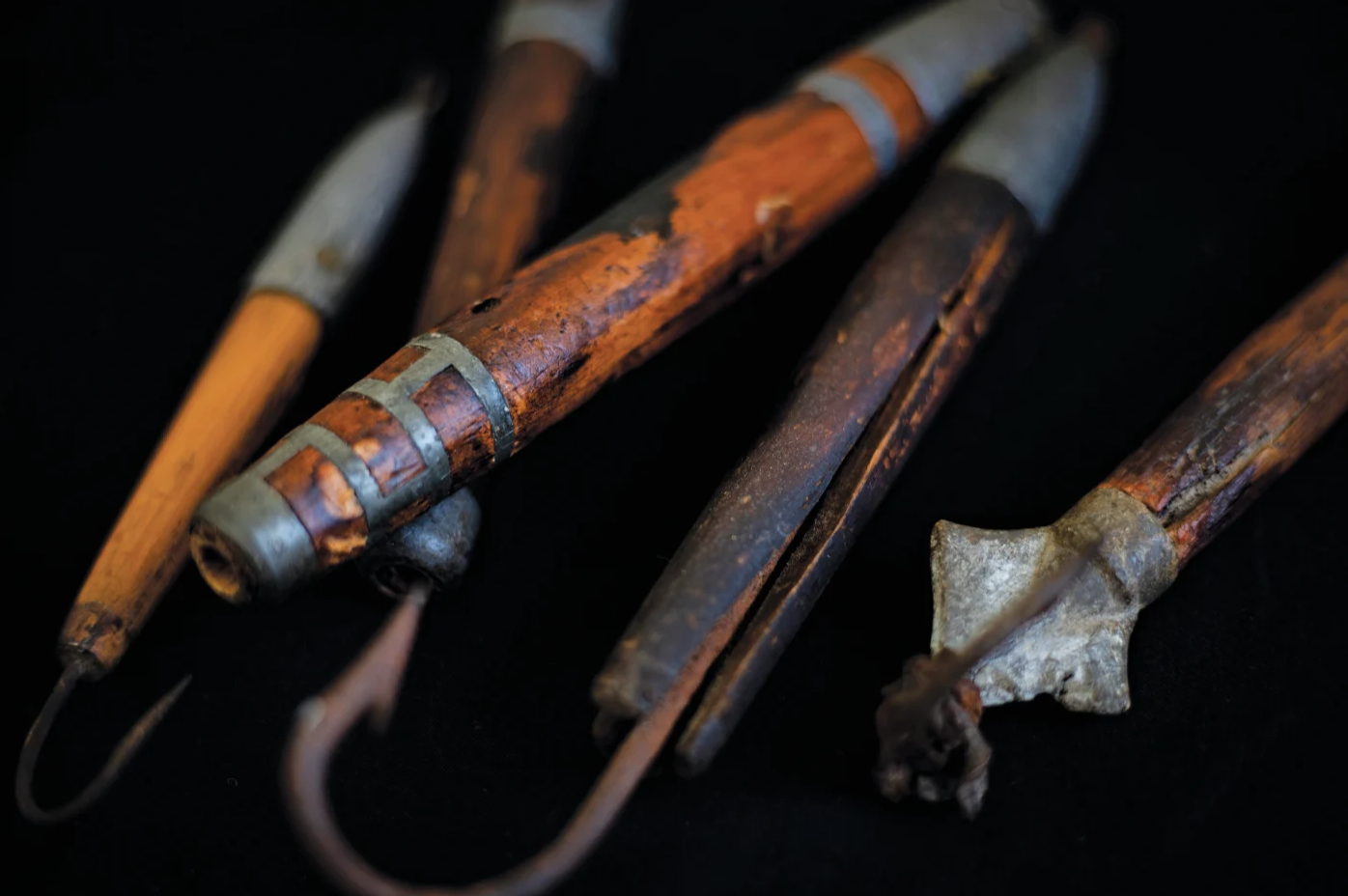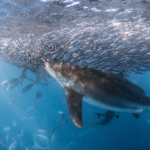Article Courtesy: anglersjournal.com | Originally Published: 9/15/20 | Click here for original article
Oldfangled
With a century of history in its wake, the simple yet effective cedar plug is still a go-to lure for tuna anglers around the globe. In a world of exotic plastics, glitter-infused paints, synthetic fur and 3-D holographic appliques, the venerable cedar plug is remarkably simple. And while it may be old-school, it remains a preferred tuna lure among professional and recreational anglers alike.
Torpedo-shaped and graceful in its no-nonsense design, a typical cedar plug has few parts: a lead head, a body made of natural cedar and a single barbed hook. A leader connects directly to the hook through the center of the lead-and-wood body. The plugs range from 4 to 8 inches in length, and although you can find them painted in a dazzling array of colors and patterns, most anglers fish them unfinished. And there’s solid logic behind pulling unadorned cedar plugs behind the boat.
“Have you ever seen a squid swimming around in the wild?” asks veteran New Jersey fisherman Jimmy Donofrio, who started his professional skippering career in 1980 aboard Drifter, a 36-foot Pacemaker. “Squid have a natural ruddy brown color with some purplish hues,” Donofrio says. “Wet, natural cedar matches this coloring almost perfectly, which makes unfinished cedar plugs an awesome lure for tuna.” Donofrio says that when bluefin tuna schooled up between Brielle, New Jersey, and Shinnecock, New York, back in the day, anglers used cedar plugs to catch them. “Plenty of guys are still using them for schoolie bluefins today,” he says.
Capt. Richard White, fishing director and manager of Tropic Star Lodge in Piñas Bay, Panama, echoes Donofrio’s thoughts about fishing unfinished plugs. The Pacific waters he fishes are thick with yellowfin tuna. “The wetted natural finish is a perfect match for squid here off Panama,” White says. “We troll them completely unfinished and maintain them with sandpaper to keep that rich, natural color when they are in the water. When we’re fishing for yellowfin tuna — which is a lot — cedar plugs are in the water. The tuna can’t resist them.”
It’s tricky to nail down precisely when cedar plugs first came into widespread use, though some charter skippers hypothesize that they became popular with the advent of motorized fishing boats. “They likely came into being once they started putting motors in boats and began trolling behind them,” Donofrio says. “I’m obviously making a guess here, but I’m pretty confident that translates to around the ’20s and ’30s.”
Capt. Dick Harris, who runs the 55-foot Omie Tillet-built Sportsman Fintastic out of Oregon Inlet, North Carolina, places the cedar plug in roughly the same time period. “I’m not a historian by any means, but Omie told me about fishing those plugs when he was 15, and that skippers were fishing them well before that,” Harris says. Tillet was born in 1929, so it’s reasonable to trace the plugs at least to the ’30s.
Harris has been fishing professionally for 43 years and says his first experiences with cedar plugs came when he was a mate aboard charter boats. “We used to have lots of school-size 40- to 70-pound bluefin off the Outer Banks, and cedar plugs were the go-to lure to catch them,” he says. “Today, I typically run them for blackfin tuna farther offshore.”
Harris continues: “We’re trolling mainly with 30- and 50-pound tackle, and I like fishing them natural, or painted black in an area where we know blackfin tuna are schooling. Those create a silhouette against the bright sky to a tuna looking up from below,” he says. “I run some of them daisy-chained on my flat lines with up to six lures right off the rod tips, while others I run through transom clips to present them a little differently. Sometimes I dress them up with skirts. I know other guys who run feathers behind the daisy chain, too. Tuna can’t stay away from them.”
Blackfin are most likely to strike cedar plugs trolled at around 7 knots, according to Harris, who notes that they track fairly straight at around 4 or 5 knots. “The faster you run, the faster they move. I run them up to 10 knots sometimes, but not often,” he says.
Off Panama, White says, the yellowfin bite is often triggered at higher trolling speeds. “We troll them with 50-pound tackle anywhere between 6 and 12 knots, depending on how fast the school is moving,” he says. “I finish off the setup with a 150-pound leader. The largest yellowfin I’ve caught on one was 214 pounds. It’s also a great lure to tie on a spinning rod for our anglers with limited experience. I tell them to cast it and reel it back in as fast as they can — little or no experience required.”
Capt. Brian Horsley, a veteran guide who has more than 40 years of experience, has used cedar plugs off North Carolina’s Outer Banks and farther offshore for everything from blackfin and yellowfin to bluefish and wahoo. Although most of his clients are fly or light-tackle anglers, he always keeps cedar plugs on board. “We had blackfin running around during our false albacore season last fall, so I kept a few cedar plugs around,” he says. “I’ve caught bluefish, wahoo, dorado — you name it. You can also sling them with spinning rods. It’s a lure I think you’ll find on almost every serious fishing boat around here.”
Capt. Barry Gibson runs charters out of Boothbay Harbor, Maine, aboard a 28-foot Whitewater center console. He recently began experimenting with cedar plugs in the Gulf of Maine for bluefin tuna during summer. “Donofrio is a good friend and has given me lots of advice for using cedar plugs for schooled-up bluefin,” Gibson says. “Most of my experience is fishing for 600- to 900-pound giant bluefin, so I’m learning. I fish cedar plugs about 15 to 20 feet behind the boat at 3 to 4 knots and run the line through transom clips to keep them up in the froth created by the boat. That disturbed water is what attracts those smaller bluefin, whereas with giant bluefin, we’d fish them much farther back. The lures track pretty straight at lower speeds.”
Tuna are not the only species susceptible to the charms of cedars. Like Horsley, Harris has had success with fish other than tuna. “We catch a decent amount of wahoo on them,” Harris says. At Tropic Star, White also reports success catching other species with the old-fashioned plugs. “Wahoo demolish them when we’re trolling fast,” he says. “We also catch a good number of mahi-mahi on them.”
Donofrio says curious white marlin will check out his cedar plug spread trolling off the Mid-Atlantic. “Every once in a while, we’ll see a white marlin poking around at them,” he says. “And I love catching skipjack tuna with them.”
After a lot of Internet surfing for cedar plug intel, I discovered some of the lure’s potential downsides in the comments on fishing forums. Many related to the narrow hook gap, which can result in lost fish. Others complained that the plugs spin out of control, though none of the skippers I spoke with have experienced these problems.
Among the online tinkerers, some say they adjust the hook’s position and notch the bottom ferrule of the plug to allow it to act as a keel of sorts. Some swap out heavier leaders with lighter fluorocarbon to promote livelier action. Real-world results will vary, of course, but there’s no doubt these lures produce.
There’s something to be said for a simple lure crafted from wood and metal that’s as effective today as it was 100 years ago. Elegant in its simplicity, the cedar plug no doubt will be bringing tuna and other fish to the boat for years to come.






